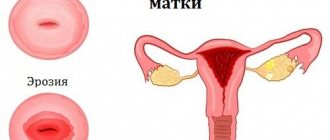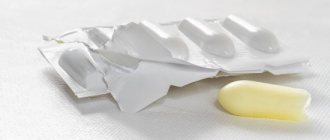Betadine for cervical erosion
Vaginal and rectal suppositories are prescribed for the treatment of various gynecological pathologies.
This dosage form is highly effective, which is associated with the direct effect of the active substance on the affected tissue. Suppositories are mainly used to treat infectious processes. Due to the fact that many pathologies are accompanied by inflammation, the use of suppositories is necessary as part of complex therapy.
One of the pathological conditions for which suppositories are often prescribed is cervical erosion. It should be noted that suppositories are usually not the basis of treatment for erosion. However, the peculiarities of the etiology and pathogenesis of the pathology often determine the need to prescribe suppositories that have an antibacterial effect.
As part of the combined treatment of cervical erosion, doctors may recommend the drug Betadine, which is available in the form of suppositories. This remedy can be used both in drug therapy and in surgical treatment.
Many women have heard about this condition of the cervix, which is called erosion. More than half of patients are diagnosed with this diagnosis both at a young and old age.
In fact, cervical erosion is referred to in the medical literature as ectopia. When talking about erosion, gynecologists mean one of several conditions of the cervix, which are designated as:
- congenital ectopia;
- true defect;
- acquired ectopia.
Thus, erosion implies a defect that forms in the area of the mucosa adjacent to the vagina. Erosion can occur in women of any age and is one of the most common conditions of the cervix.
It is noteworthy that cervical erosion does not always indicate the presence of pathology. In general, erosion is not a disease and has a benign course. However, we should also not forget that it is a background for the development of more dangerous ailments, such as dysplasia or cervical cancer.
Indications for use
Acute and chronic vaginal infections (vaginitis):
Mixed infections
Nonspecific infections (bacterial vaginosis, Gardene
re lla vag
.)
Fungal infections ( Candida albicans
)
Vaginal infections due to treatment with antibiotics and steroid drugs
Trichomoniasis ( Trichomonas
vaginalis )
(if necessary, combined systemic treatment should be carried out).
Preoperative and postoperative treatment (for the purpose of prevention) before and after surgical operations on the vagina, as well as obstetric and diagnostic procedures.
Options
The concept of “erosion” includes several types that differ from each other according to different criteria. To determine their features, it is necessary to consider the structure of the cervix.
The cervix is a muscular tube between the organ cavity and the vagina. It consists of two parts:
It is worth noting that the supravaginal part of the cervix is not accessible for examination. During a gynecological examination, the doctor palpates only the vaginal part. This area got its name due to the localization features.
In the speculum, the vaginal part of the cervix is defined as a pink, smooth area of the mucosa. Such external signs are caused by flat stratified epithelium.
The cervical canal is located inside the cervix, the surface of which is significantly different from the area adjacent to the vagina. The cervical canal is quite narrow, and its surface is lined with single-layer cylindrical cells, giving the mucosa a reddish color and velvety texture.
The cervical canal performs an important function. Thanks to the presence of the cervical canal, it becomes possible to reject and remove menstrual blood and promote sperm after sexual intercourse. One of the functions of the cervical canal is to protect the sterile uterine cavity from infections that can enter from the vagina. This is achieved by the activity of the glands that produce a special secretion.
Quite often, women are diagnosed with erosion in the form of ectopia, which involves the replacement of squamous multilayer epithelium with columnar single-layer cell elements. Ectopia can be either congenital or acquired.
- Congenital erosion has long been considered a pathology. The defect is detected in girls and women, which regresses on its own over time. Thanks to the introduction and use of modern research methods, scientists have established that congenital ectopia is one of the stages in the development of the reproductive tract. During the development of the female genital organs, the vaginal part of the cervix is lined with columnar epithelium. With the onset of puberty and the influence of hormones on the cervical epithelium, ectopia begins to regress. By the age of 25, the spot should completely disappear. However, estrogen deficiency is observed in various hormonal disorders. In this case, the defect disappears later and infection may occur.
- Acquired erosion is a consequence of the pathological condition of the cervix, in which a wound is initially formed. Violation of the integrity of the cervical epithelium occurs due to various traumatic factors that have a detrimental effect on the mucous membrane. This wound, called true erosion, lasts for about two weeks and then heals. The wound often shows signs of inflammation. When such an ulcer begins to heal, the recovery process is disrupted. The surface of the ulcer is covered with cells of the cervical canal, forming an ectopia. Acquired ectopia in most cases is accompanied by other diseases, in particular infectious ones. Therefore, remediation is necessary before eliminating such a defect.
The following factors lead to different types of erosion:
- hormonal fluctuations;
- infections;
- injuries of the cervical epithelium;
- weakened immunity;
- heredity.
Contraindications for use
Betadine suppositories (instructions for use are attached below), practically, like all medications, have contraindications for their use.
These include:
- 2nd and 3rd trimesters of pregnancy;
- children under eight years of age;
- chronic infection, accompanied by rash and itching;
- radioactive iodine therapy;
- thyrotoxicosis;
- benign/malignant tumor of the thyroid gland;
- use of antibiotics;
- hepatitis herpetiformis;
- Dühring's dermatitis;
- individual iodine intolerance.
During the lactation period and from the 2nd trimester of pregnancy, you should take the medication under the supervision and with the permission of a doctor.
Symptoms and treatment methods
The occurrence of erosion is not accompanied by signs that would indicate pathology. If the defect is not complicated by other diseases, a woman may notice spotting after sexual intercourse and examination of the cervix by a doctor. These discharges are associated with increased susceptibility of the area with cylindrical cells, which is often subject to trauma.
Sometimes with ectopia there is an increase in the amount of mucous discharge. Their appearance is associated with the glands of cylindrical cells that produce mucus. If a vaginal smear is performed, an increased level of leukocytes may be detected in the absence of inflammation.
In more than 80% of cases, erosion is complicated and is accompanied by the following symptoms:
- pain syndrome;
- discomfort in the genital area;
- bleeding and acyclic spotting;
- cycle disorders;
- pathological discharge that may have an unpleasant odor.
Erosion can be detected by examining the cervix in a speculum. Different types of erosion have their own visual signs:
- congenital ectopia has an even shape and a visible transition zone;
- true erosion is accompanied by the formation of a stain;
- pseudo-erosion is manifested by a defect of different volume and shape.
To confirm the diagnosis and exclude more dangerous diseases, differential diagnosis should be carried out, implying:
- colposcopy in simple and advanced versions;
- flora smear;
- cytological examination;
- bacterial sowing;
- PCR for detection of sexually transmitted infections;
- biopsy if dysplasia or cancer is suspected.
Betadine suppositories
Betadine suppositories contain iodine as an active ingredient. Thanks to the connection with polyvinylpyrrolidone, Betadine has a pronounced antiseptic effect. Betadine suppositories can destroy the cell membrane of some bacteria and fungi.
Betadine suppositories are not antibacterial agents. They are often used as part of complex therapy. Betadine is used in the following cases
- trichomoniasis and other infectious diseases;
- vulvovaginitis;
- cervicitis;
- prevention of inflammation before cauterization.
Betadine suppositories are effective against viruses, protozoa, fungi, gram-positive and gram-negative bacteria. The active substance of vaginal suppositories almost does not penetrate into the general bloodstream. That is why the drug can be used during pregnancy and breastfeeding.
Gynecologists emphasize that Betadine suppositories can be used to prevent infections after unprotected sexual intercourse. For this purpose, it is necessary to use candles no later than two hours after intimacy.
In some cases, suppositories called Betadine are not recommended for use with complicated cervical erosion:
- hypersensitivity to iodine;
- dysfunction of the thyroid gland;
- renal pathology;
- age up to eighteen years.
Quite rarely, side effects may occur when using Betadine suppositories for cervical erosion. If the patient notices discomfort, vaginal dryness, burning, the drug should be stopped.
Betadine suppositories for erosion should be taken in the course recommended by your doctor. In case of long-term treatment with suppositories, the following side effects may develop:
- gastrointestinal disorders;
- metallic taste;
- redness of the eyelids;
- rash;
- tachycardia;
- sleep disorders;
- excessive salivation;
- swelling of the throat.
The course of treatment with Betadine suppositories is a week, subject to once daily use. In some cases, the duration of treatment can be increased to fourteen days. Before inserting the suppository into the vagina, it should be moistened with water. After therapy, it is advisable to perform a smear on the flora no earlier than 4 weeks from the moment the last suppository was administered.
Betadine - description and action
Medicine Betadine
for local use belongs to the class of antiseptics.
It is presented in various dosage forms:
- suppositories (suppositories) for intravaginal administration, weight - 0.2 g;
- solution for gargling and for other purposes 10%, volume - 0.125, 1 l;
- ointment 10%, 20 g in tube.
Suppositories are packaged in blister packs of 7 pieces, in packs of 1 and 2 blisters. A pack of 7 candles costs 480 rubles
, for 14 candles you will have to pay
590 rubles
. The suppositories are dark brown in color and have a torpedo shape.
The active substance of the drug is povidone-iodine, and 200 mg of this substance contains about 24 mg of iodine. An additional ingredient is the preservative macrogol 1000.
You need to store the product in the refrigerator, since the temperature should not be higher than 15 degrees. Children's access to medicine must be strictly limited!
The main actions of the drug are disinfectant, antiseptic, antiprotozoal, antimycotic.
Suppositories help cope with various types of infections - bacteria, fungi, protozoa. As a result of the release of iodine, which has a bactericidal effect, the drug promotes the death of microbial cells within a minimum period of time. Iodine is able to block the proteins of pathogenic microbes, causing them to clot. As it works, the iodine becomes discolored.
The drug is almost not absorbed into the bloodstream, but is released slowly inside the vagina, which provides a prolonged effect. The result is:
- elimination of itching, burning, pain;
- restoration of the microflora of the reproductive tract.
The drug is non-toxic and not addictive. According to clinical trials, after using Betadine, its effect is observed after 15 seconds, and the complete elimination of microbes occurs in a minute. The substance works most actively against staphylococcus, streptococcus, E. coli, and destroys a number of viruses.
TOP 10 most effective suppositories for cervical erosion
Treatment of ectopia is carried out both surgically and medicinally. The operation is indicated for large-scale lesions of the mucous membrane, and small ulcerations can be cured with medications. Suppositories are often prescribed for erosion. The list of the most effective suppositories that are used for changes in the cervix is considerable. Each product has indications and limitations that you need to familiarize yourself with in advance.
Erosion concept
Ectopic cervix is characterized by damage to the mucous membrane and the formation of defects in the form of ulcers. It can develop in absolutely any woman, but girls aged 25–45 years are more susceptible to the pathology.
There are many causes of ulceration. The appearance of erosion is caused by:
- early onset of sexual activity;
- penetration of pathogenic microflora - gonococci, trichomonas, chlamydia;
- organ injury;
- hormone imbalance.
Stress, overwork, and excessive physical activity also lead to the formation of a defect.
The pathology occurs latently for a long time, which leads to the development of complications. Since uterine disease is prone to transformation into cancer, it is recommended to undergo an examination at least once a year. Only through examination can changes be detected and consequences prevented.
While the ulcers have no minor manifestations. As erosion grows, the following occurs:
- painful periods;
- discomfort during intimacy;
- copious discharge.
If you notice such signs, you should consult a doctor. After clarifying the diagnosis, if the lesion is small, the doctor will prescribe suppositories for erosion
Don't hesitate to visit the hospital. Refusal to treat a disease on the cervix, ignoring the manifestations, is fraught with malignancy, malfunctions of the reproductive and reproductive systems, and infertility.
pharmachologic effect
Suppositories for erosion in the cervix deliver useful substances to the lesion. The soft base ensures a uniform effect on the entire damaged mucosa. It is better to use suppositories as part of complex therapy, together with medications for oral administration.
The use of the medication provides:
- elimination of inflammation;
- increasing the protective properties of the body;
- destruction of bacteria;
- healing of damaged areas;
- normalization of the balance of vaginal microflora;
- removal of pathological secretions.
Candles come in different names. Some drugs have identical compositions. From the annotations of medications, the following actions are known:
- antiviral,
- restorative,
- wound healing,
- antifungal,
- anti-inflammatory.
Drug interactions
The povidone-iodine complex has an antimicrobial effect in the pH range of 2.0-7.0. Interaction with proteins and other unsaturated organic substances reduces its effectiveness.
The use of povidone iodine simultaneously or immediately after the use of antiseptic preparations containing octenidine on the same or adjacent skin area may cause a temporary dark discoloration of the treated areas of the skin.
Regular use of Betadine should be avoided in patients receiving lithium preparations.
Indications and contraindications
Only a doctor can prescribe the use of healing suppositories after cauterization of cervical erosion or for girls whose disease has begun to develop. Before taking the medicine, you must study the restrictions on use.
Table - Who can and cannot be treated with suppositories
Indications
Contraindications
- Initial degree of damage;
- unrealized motherhood;
- infectious process;
- irregular periods;
- inflammation of the uterus;
- mucosal injury;
- after and before cauterization of cervical erosion
- Individual intolerance to the components of the drug;
- large-scale damage to the mucosa (if the defect is more than 2 cm);
- dysplasia 3rd degree;
- high risk of malignancy.
Compound
The main active ingredient is povidone-iodine in a dosage of 200 mg. Packed in 7 vaginal suppositories in blisters made of polymer material, 1 or 2 packages together with annotation in cardboard boxes.
Betadine suppositories are vaginal suppositories used to treat almost all types of fungi and infections of the vagina.
Types of suppositories
There are many effective drugs that help in healing the cervix. Pathology is treated with the following vaginal suppositories:
- Antiseptic (Depantol, Terzhinan) - ensure disinfection of the mucous membrane and restoration of microflora.
- Anti-inflammatory (Hexicon, Viferon) - eliminate the symptoms of inflammation.
- Antibacterial (Methyluracil, Clotrimazole) - destroy pathogens.
- Contraceptives (Pharmatex, Benatex) - to stabilize hormonal levels.
You cannot treat cervical erosion with a remedy recommended by a pharmacist or relative. The doctor prescribes the drug, taking into account the severity of the pathology, associated problems, age and other characteristics of the body.
Sea buckthorn candles
Thanks to the vitamins and minerals contained in the suppositories, they have pronounced anti-inflammatory properties. The drug is used against cervical erosion, as it has antispasmodic, antiseptic and healing properties. Suppositories are also ways to stop bleeding. Under the influence of active substances, the mucous membranes are restored. The course of treatment with suppositories is one and a half weeks.
Honey suppositories
The drug from the product is widely used. The medicine ensures rapid healing of erosions and strengthens the immune system. Before use, keep the product in the freezer. It is recommended to carry out the procedure three times a day.
Directions for use and doses
For intravaginal administration.
The suppository is recommended to be used in the evening, before bedtime. The Betadine suppository is removed from the shell and inserted deep into the vagina. To maximize the dissolution of the active substance and prevent local irritation, it is recommended to moisten the suppository with water before administration.
For acute vaginitis, use 1-2 times a day for 7 days, for subacute and chronic vaginitis, 1 time a day before bed for 14 days. During treatment with suppositories, the use of sanitary pads is recommended. The drug should be used daily. There is no need to interrupt treatment during menstruation.
Use during pregnancy
There are few drugs that are allowed to be used during pregnancy. Among the harmless ones are sea buckthorn candles. If the erosion bleeds, it is possible to prescribe methyluracil suppositories. All other remedies are prohibited for pregnant women, especially during the first three months. The use of Livarol, Suporon, Terzhinan, Betadine can have a detrimental effect on the course of pregnancy and the condition of the baby.
The use of Clotrimazole, Depantol and Hexicon is possible, but only if absolutely necessary.
Bloody discharge from suppositories
The use of suppositories for ectopia should not be accompanied by such a symptom. The sign may indicate infection or the presence of a concomitant disease (endometriosis, cyst). If, during the treatment of ulcerations on the cervix, bleeding appears, the use of the drug should be discontinued. To find out the exact cause, you need to consult a doctor.
special instructions
During use of povidone-iodine, iodine uptake by the thyroid gland may be decreased, which may affect the results of some diagnostic tests (eg, thyroid scintigraphy, protein-bound iodine, radioiodine measurements), and may also interact with iodine supplements used. for the treatment of thyroid diseases. To obtain undistorted research results after long-term therapy with povidone-iodine, it is recommended to maintain a sufficiently long period of time (1-2 weeks) without this drug.
Due to the oxidizing properties of povidone-iodine, trace amounts of povidone iodine may cause false-positive results in some types of tests using toluidine or guaiac resin to detect occult blood (hemoglobin) in the stool or blood or glucose in the urine.
In case of skin irritation, contact dermatitis or hypersensitivity, the use of the drug should be discontinued.
Do not heat the drug before use.
Significant amounts of iodine can cause hyperthyroidism in patients with thyroid dysfunction (for example, nodular colloid or endemic goiter). In such patients, the use of Betadine vaginal suppositories should be limited in time and the area of the skin surface being treated. If symptoms of hyperthyroidism occur during treatment, thyroid function should be checked.
Instructions for use:










